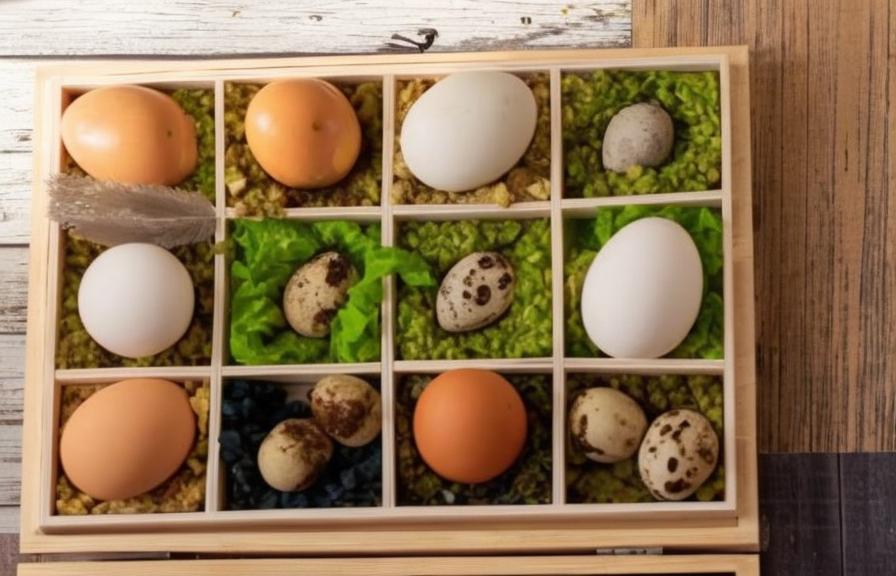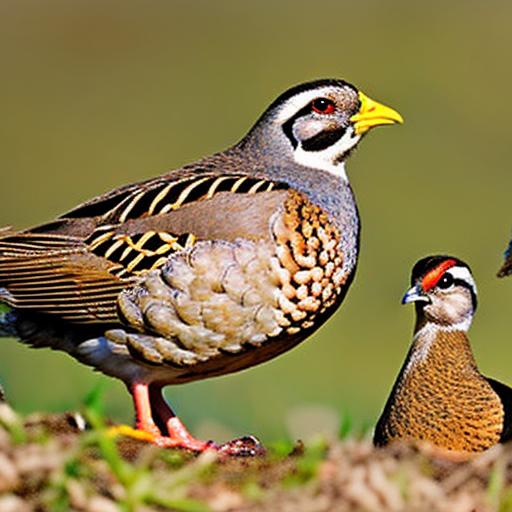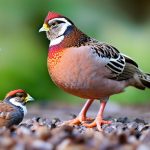Keeping quail with chickens is a popular practice among homesteaders and small-scale farmers. Quail and chickens can coexist in the same space, providing a variety of benefits for the farmer and the animals. Quail are small, ground-dwelling birds that are known for their high egg production and delicious meat. Chickens, on the other hand, are larger birds that also provide eggs and meat. When kept together, quail and chickens can complement each other in terms of foraging, pest control, and social dynamics. However, there are several considerations to keep in mind when housing and managing quail and chickens together to ensure their health and well-being.
Key Takeaways
- Keeping quail with chickens can be a beneficial and efficient way to manage a small farm or backyard setup.
- When housing quail and chickens together, it’s important to consider the space and nesting requirements for both species.
- Feeding and watering arrangements should be carefully planned to ensure that both quail and chickens have access to the appropriate food and water.
- Health and disease management is crucial when keeping quail and chickens together, as they can potentially transmit diseases to each other.
- Managing social dynamics between quail and chickens requires observation and potential intervention to prevent aggression and ensure harmonious cohabitation.
Considerations for Housing Quail and Chickens Together
When housing quail and chickens together, it’s important to consider the size and layout of the coop or housing area. Quail are ground-dwelling birds that prefer to stay close to the ground, while chickens are more inclined to roost at higher levels. Therefore, the housing area should have both ground-level space for the quail and elevated roosting areas for the chickens. Additionally, it’s important to provide separate nesting boxes for both quail and chickens to lay their eggs. Quail prefer to lay their eggs in secluded areas, while chickens may use communal nesting boxes. Providing separate nesting areas will help reduce competition and stress between the two species. Furthermore, the housing area should have adequate ventilation and lighting to ensure the health and comfort of both quail and chickens. Proper ventilation will help prevent respiratory issues, while adequate lighting will support egg production and overall well-being.
In addition to the physical layout of the housing area, it’s important to consider the bedding and flooring materials. Quail and chickens have different bedding requirements, with quail preferring a softer material such as straw or wood shavings, while chickens may do well with straw or pine shavings. Providing separate bedding areas for quail and chickens will help maintain cleanliness and hygiene in the coop. It’s also important to regularly clean and maintain the housing area to prevent the buildup of waste and potential health issues for both quail and chickens. Overall, careful consideration of the housing layout, nesting areas, bedding materials, ventilation, and cleanliness is essential for successfully keeping quail and chickens together.
Feeding and Watering Quail and Chickens in the Same Space
Feeding and watering quail and chickens in the same space requires careful management to ensure that both species receive adequate nutrition and access to resources. Quail and chickens have different dietary requirements, with quail needing a higher protein diet compared to chickens. When providing feed for both species, it’s important to offer a balanced diet that meets the nutritional needs of both quail and chickens. This may involve providing a commercial feed specifically formulated for mixed poultry flocks or offering separate feeds for quail and chickens. Additionally, offering supplemental treats such as mealworms or greens can provide enrichment and variety in their diet.
In terms of watering, it’s important to provide multiple water sources to ensure that both quail and chickens have access to clean water at all times. Quail prefer shallow water dishes or nipple drinkers, while chickens may use traditional waterers or open dishes. Providing multiple watering options will help prevent competition and ensure that all birds have access to water. It’s also important to regularly clean and refill water dishes to maintain hygiene and prevent the spread of disease. Overall, careful management of feeding and watering practices is essential for meeting the nutritional needs of both quail and chickens in the same space.
Health and Disease Management for Quail and Chickens
Maintaining the health of quail and chickens when kept together requires proactive disease management and biosecurity measures. Quail and chickens are susceptible to different diseases, so it’s important to be aware of potential health risks and take preventive measures to minimize the spread of disease. This may involve implementing biosecurity protocols such as quarantining new birds, limiting exposure to wild birds, and regularly disinfecting the housing area. Additionally, it’s important to monitor the health of both quail and chickens regularly for signs of illness or distress.
In terms of disease management, it’s important to be aware of common diseases that affect quail and chickens, such as respiratory infections, coccidiosis, and external parasites. Understanding the symptoms and preventive measures for these diseases can help minimize their impact on the flock. Additionally, working with a veterinarian who has experience with poultry can provide valuable guidance on disease management and treatment options. Overall, proactive disease management, biosecurity measures, regular health monitoring, and access to veterinary care are essential for maintaining the health of quail and chickens when kept together.
Managing Social Dynamics between Quail and Chickens
Managing social dynamics between quail and chickens is an important aspect of keeping them together in the same space. Quail are generally more timid and prefer to stay close to the ground, while chickens may be more assertive and territorial. It’s important to provide enough space for both species to move around freely without feeling crowded or stressed. Additionally, providing hiding spots or visual barriers can help quail feel more secure in the presence of chickens.
When introducing new birds or integrating different age groups, it’s important to monitor their interactions closely to prevent aggression or bullying. This may involve gradually introducing new birds to the flock or providing separate areas for different age groups until they can be integrated safely. Additionally, providing multiple feeding and watering stations can help reduce competition and prevent one species from dominating access to resources. Overall, careful management of social dynamics through space, visual barriers, monitoring interactions, and providing multiple resources is essential for maintaining harmony between quail and chickens.
Potential Benefits of Keeping Quail with Chickens

Keeping quail with chickens can provide a variety of benefits for homesteaders and small-scale farmers. Quail are known for their high egg production, with some species laying up to 300 eggs per year. By keeping quail with chickens, farmers can diversify their egg production and have access to smaller eggs that are popular among consumers. Additionally, quail eggs are known for their rich flavor and nutritional value, making them a valuable addition to a farm’s product offerings.
In addition to egg production, quail are also valued for their delicious meat. By raising quail alongside chickens, farmers can diversify their meat production and offer a unique product to consumers. Quail meat is known for its tender texture and rich flavor, making it a popular choice for gourmet dishes. Furthermore, quail are efficient converters of feed into meat, making them a cost-effective option for small-scale meat production.
From a pest control perspective, keeping quail with chickens can provide natural pest management in the farm environment. Quail are known for their insect-eating habits, which can help reduce pest populations in the surrounding area. By allowing quail to forage alongside chickens, farmers can harness their natural pest control abilities to reduce reliance on chemical pesticides.
Overall, keeping quail with chickens can provide a range of benefits including diversified egg production, meat production, natural pest control, and product offerings for consumers.
Conclusion and Final Considerations for Keeping Quail with Chickens
In conclusion, keeping quail with chickens can be a rewarding practice that provides a variety of benefits for homesteaders and small-scale farmers. However, it’s important to carefully consider housing arrangements, feeding and watering practices, health management, social dynamics, and potential benefits when integrating quail with chickens. By providing a suitable housing environment with proper ventilation, lighting, bedding materials, nesting areas, feeding options, watering sources, disease management protocols, social management strategies, and potential benefits such as diversified egg production, meat production, natural pest control, farmers can successfully keep quail with chickens in the same space.
Ultimately, successful integration of quail with chickens requires careful planning, proactive management practices, regular monitoring of health and social dynamics, access to veterinary care when needed, and a commitment to providing a healthy environment for both species. With proper care and attention to their specific needs, quail and chickens can coexist harmoniously while providing a range of benefits for the farmer and the farm ecosystem as a whole.
If you’re considering keeping quail with chickens, it’s important to understand the dynamics of raising different poultry species together. While quail and chickens can coexist, there are certain considerations to keep in mind. For more insights on raising multiple types of poultry, you may find the article on creating a garden chicken coop helpful. This resource provides valuable tips on creating a harmonious environment for various poultry species within the same space.
FAQs
Can I keep quail with chickens?
Yes, it is possible to keep quail with chickens, but there are some considerations to keep in mind.
What are the considerations for keeping quail with chickens?
Quail and chickens have different housing and dietary needs, so it’s important to provide separate areas for them to live and eat.
Do quail and chickens get along?
In general, quail and chickens can coexist peacefully, but it’s important to monitor their interactions to ensure that there is no aggression or bullying.
What are the benefits of keeping quail with chickens?
Keeping quail with chickens can provide a diverse and interesting flock, as well as potential benefits for pest control and egg production.
Are there any potential drawbacks to keeping quail with chickens?
Quail and chickens have different space and dietary requirements, so it’s important to carefully manage their cohabitation to ensure the health and well-being of both species.
Meet Walter, the feathered-friend fanatic of Florida! Nestled in the sunshine state, Walter struts through life with his feathered companions, clucking his way to happiness. With a coop that’s fancier than a five-star hotel, he’s the Don Juan of the chicken world. When he’s not teaching his hens to do the cha-cha, you’ll find him in a heated debate with his prized rooster, Sir Clucks-a-Lot. Walter’s poultry passion is no yolk; he’s the sunny-side-up guy you never knew you needed in your flock of friends!







